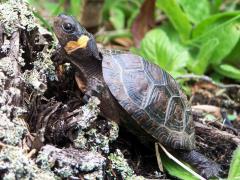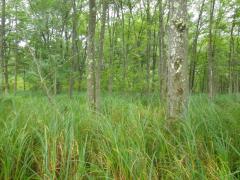Bog Turtle Habitat Evaluation
Conserve Wildlife Foundation is assessing historic bog turtle sites for future habitat restoration projects.
 Zoom+ Adult bog turtle (Glyptemys muhlenbergii). © Kristen Meistrell
Zoom+ Adult bog turtle (Glyptemys muhlenbergii). © Kristen Meistrell
The state endangered bog turtle, Glyptemys muhlenbergii, is a small, secretive turtle with a dark brown shell and distinctive oranges patches at the rear of its head. At maturity, bog turtles only reach 4 ½ inches in length, making them the smallest turtle in North America. Bog turtles are habitat specialists; they inhabit open, unpolluted wetlands, including spring-fed fens, sphagnum bogs, and wet pastures. Bog turtles require mucky soils, with a mosaic of small pools of groundwater and drier upland areas and low vegetation. Eggs are laid in the spring on elevated grassy tufts in ample sunlight. In the fall bog turtles will retreat to forested wetland habitat where they hibernate in the root systems of trees.
 Zoom+ Bog turtles require a mosaic of habitat, including forested wetlands for hibernation.
Zoom+ Bog turtles require a mosaic of habitat, including forested wetlands for hibernation.
Historically, bog turtles ranged from upstate New York through Georgia and as far west as Tennessee; however, continued development and habitat degradation has destroyed much of the bog turtles' habitat and in 1997 they were listed as a Federally Threatened species. Currently 90% of bog turtle habitat is on private land and more than half of the Northeast's bog turtles are found in New Jersey.
Together with the US Fish and Wildlife Service (USFWS) and NJ's Endangered and Nongame Species Program (ENSP), CWF is working to restore and enhance bog turtle habitat in New Jersey.
 Zoom+ The unique fen plant communites found at bog turtle sites are susceptible to encroachment by invasive species like cattail and purple loosestrife.
Zoom+ The unique fen plant communites found at bog turtle sites are susceptible to encroachment by invasive species like cattail and purple loosestrife.
CWF biologists are visiting high priority bog turtle sites with historic turtle records and evaluating the status of the habitat. Bog turtle habitat is highly susceptible to succession and encroachment by invasive plants. Runoff, sedimentation, and surrounding development create ideal conditions for phragmites, reed canary grass, and purple loosestrife. These non-native plants will form monocultures in the open wetlands, changing the hydrology and out-competing the native plant communities that bog turtles depend upon. Mechanical removal, wetland approved herbicides, or controlled grazing by cows or goats are used to control succession and invasive species encroachment.
By reaching out to landowners and discussing potential habitat restoration and incentive options, CWF is working to increase awareness and appreciation of bog turtles while improving and increasing habitat for this imperiled species.
Find Related Info: Endangered, Reptiles





